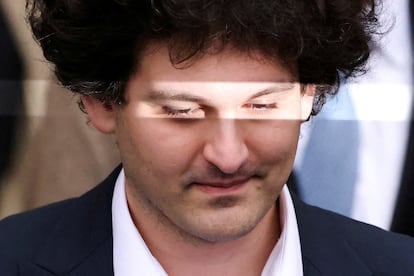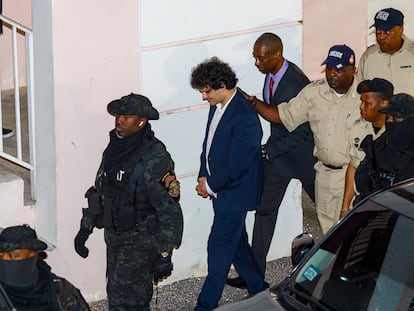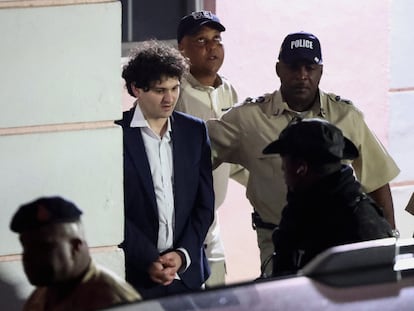Sam Bankman-Fried, billionaire before 30 and now a possible 100-year prison sentence at 32: The downfall of the cryptocurrency king
The former financier is facing the possibility of a lengthy sentence after being convicted of fraud and conspiracy. The sentence will be announced this Thursday

The second week of November 2022 was a bumpy one for Sam Bankman-Fried. The U.S. tycoon, who was 30 years old at the time, failed to raise funding for his two main businesses, cryptocurrency exchange platform FTX and investment fund Alameda Research. It was too late for him to get anyone to invest with him. His fortune, which on that Monday was estimated at $16 billion, completely evaporated on Friday, and his companies filed for bankruptcy. However, the week of his sensational fall may not have been the worst of his life. This week he faces the possibility of being sentenced to 110 years in prison.
Sam Bankman-Fried, or SBF as he is known, was convicted in November 2023 for utilizing money from users of his platform to fund various personal projects, but his sentence remains to be determined. On the one hand, SBF is up against a judge who no longer views him favorably after his attempts to manipulate witnesses throughout the trial. On the other, he remains hopeful that returning the more than $8 billion lost by the victims could reduce his sentence. The combination of factors shaping the case leaves considerable uncertainty as to the final verdict.
So, how long could he spend behind bars? The maximum sentence for the seven counts of fraud and conspiracy for which he was convicted amounts to more than a century. Yet, its enforcement is not usually the norm for this type of crime: most white-collar offenders whose sentences equate to the rest of their lives end up serving only part of them. One example is Elizabeth Holmes, who will only serve 11 of the 80 years she faced for fraud involving the startup Theranos, which promised blood tests with just a prick of the finger. If Bankman-Fried receives the maximum punishment, he would have the fifth-largest sentence for financial crimes in the U.S., behind Bernie Madoff, who ranks fourth after being sentenced to 150 years in 2009 for the largest Ponzi scheme in history.
Beyond punishment
The parallels with the Madoff case compromise Bankman-Fried’s situation. At the sentencing of the former’s case, Judge Denny Chin stressed the importance of a maximum penalty for crimes of this magnitude due to their symbolic significance: “The message conveyed is that, in a society governed by law, those like Mr. Madoff will receive the punishment they deserve, in keeping with their moral culpability.” The judge also underlined the deterrent role of the sentence: “It is crucial to send a strong message to those contemplating similar acts that they will be caught and punished to the maximum extent of the law.”
Bankman-Fried’s fate rests entirely in the hands of the judge. The U.S. judicial system grants the magistrate absolute power to determine the sentence, constrained only by the maximum established for each offense. Whether or not he receives guidance from the defense, the Prosecutor’s Office and other stakeholders, the judge relies primarily on his or her own perception of the severity of the crime and the culpability of the defendant. There is also a good chance that the punishment given to SBF will not only serve as a sanction, but also as an example to deter others.
The former cryptocurrency guru has certainly not kept a low profile in the process. SBF was initially placed under house arrest during the trial, but this privilege was revoked when he was found to have repeatedly violated the terms of his probation. Suspicions of fund transfers to conceal assets, covert internet activities and improper communications landed him several warnings, until it was confirmed that he had leaked the personal diary of his ex-girlfriend and former CEO of Alameda Research, Caroline Ellison, a central witness in the case. The United States Department of Justice claimed that Bankman-Fried leaked the diary to discredit and intimidate Ellison, who confessed to feeling unfit to manage the Alameda fund in her writings. In addition, SBF provided false statements during his testimony and employed the customary strategy of answering “I don’t recall” on more than 140 occasions to avoid incriminating himself when questioned by the prosecutor.
The last attempt
However, Bankman-Fried remains hopeful. For the final stages he hired star attorney Marc Mukasey to lead his defense. Mukasey previously defended Donald Trump in a case involving the legality of his candidacy, although his major success came when he succeeded in lowering the sentence — from 11 years in prison to just four — for Trevor Milton, the former CEO of Nikola. Milton, accused of misleading investors about the progress of his electric truck company’s first prototype, went to the extent of producing a video in which he tilted the camera to simulate the operation of his vehicle, when in fact it was only rolling downhill.
Through a report with various sections titled “Sam is not motivated by greed,” “Sam’s caring for individuals,” and “Sam’s philosophy and philanthropy,” SBF’s defense is seeking to sugarcoat its client’s image and attribute many of the charges against him to mismanagement, rather than a deliberate scheme to divert funds, such as “false statements to obtain a bank loan that is planned to be repaid.” The report’s final recommendation is that Bankman-Fried should serve from five years and three months to six and a half years in prison, arguing that “a sentence that would allow Sam to quickly reintegrate into a productive role in society would be sufficient [...] to fulfill the objectives of the sentence.”
SBF also has an ace up its sleeve. Some of his investments through FTX have performed well and through the efforts of the team handling the bankruptcy they may be able to offset all the losses incurred by the platform’s users. Andrew Dietderich, the team’s attorney, stated that the payment should not be regarded as “a guarantee, but as an objective. There is still a great amount of work and risk ahead, but we believe the objective is within reach and we have a strategy to achieve it.” Reimbursing account owners on the now-closed platform would help remedy the harm to victims and could be crucial to reducing the length of Bankman-Fried’s sentence.
Nevertheless, this situation would not invalidate the prosecutor’s main argument: even if the effects can be mitigated, Bankman-Fried is still chiefly responsible for the fraud that sent FTX into bankruptcy. Although SBF may have argued that he simply failed to manage the business and that he did not orchestrate any illegal actions in his companies, his testimony was contradicted by all the others involved in the process. A striking example is the testimony provided by Caroline Ellison, who claimed that Bankman-Fried directly ordered user funds to be utilized to repay loans. His former flatmates, Adam Yedidia, Gary Wang (FTX co-founder) and family friend Nishad Singh also claimed that they worked under Bankman-Fried’s orders.
The prosecutor’s office is seeking 40 to 50 years for Bankman-Fried. According to the prosecution, SBF’s recent behavior has been characterized by “unparalleled greed and arrogance, taking risks and repeatedly gambling with other people’s money.” They believe that Bankman-Fried shows no remorse and that the severity of his crimes should not be ignored: “Justice requires that he receive a prison sentence commensurate with the extraordinary dimensions of his crimes.” After November’s verdict, Damian Williams, U.S. Attorney for the Southern District of New York, stated that, “the crypto industry might be new, but this kind of fraud, this kind of corruption, is as old as time.”
Many legal experts anticipate that Bankman-Fried will be spending at least several decades behind bars. As attorney Mitchell Epner of Rottenberg Lipman Rich told Forbes, it would be surprising if SBF received less than 25 years in prison. Former federal prosecutor Paul Tuchmann also predicted that victim characteristics could lead to a higher sentence: “A lot of the losses in this case were small investors, which really tends to create a greater pressure for a significant sentence,” he told CNBC. The professor of Law at Columbia University, John Coffee, told The New York Times that judge Kaplan is known for being “fair, but not overly lenient,” and estimated a minimum sentence of 20 years, but he is not ruling out a sentence of up to 50 years.
Sam Bankman-Fried has a lot going against him. Even the time it took the jury to reach a verdict — just four hours — suggests that its members were completely convinced. The crimes for which he was convicted do not even afford the possibility of a life sentence, which would at least offer a more realistic chance of parole in the future in New York State. The former billionaire now faces possible “death by incarceration,” as the U.S. media describes it, at the hands of a judge with whom he developed the worst possible relationship. Facing the uncertainty of the final verdict, Bankman-Fried can only be sure of one thing: even if the sentence falls short of expectations, it will cost him too many years of his life.
Sign up for our weekly newsletter to get more English-language news coverage from EL PAÍS USA Edition
Tu suscripción se está usando en otro dispositivo
¿Quieres añadir otro usuario a tu suscripción?
Si continúas leyendo en este dispositivo, no se podrá leer en el otro.
FlechaTu suscripción se está usando en otro dispositivo y solo puedes acceder a EL PAÍS desde un dispositivo a la vez.
Si quieres compartir tu cuenta, cambia tu suscripción a la modalidad Premium, así podrás añadir otro usuario. Cada uno accederá con su propia cuenta de email, lo que os permitirá personalizar vuestra experiencia en EL PAÍS.
¿Tienes una suscripción de empresa? Accede aquí para contratar más cuentas.
En el caso de no saber quién está usando tu cuenta, te recomendamos cambiar tu contraseña aquí.
Si decides continuar compartiendo tu cuenta, este mensaje se mostrará en tu dispositivo y en el de la otra persona que está usando tu cuenta de forma indefinida, afectando a tu experiencia de lectura. Puedes consultar aquí los términos y condiciones de la suscripción digital.
More information
Archived In
Últimas noticias
Most viewed
- Sinaloa Cartel war is taking its toll on Los Chapitos
- Oona Chaplin: ‘I told James Cameron that I was living in a treehouse and starting a permaculture project with a friend’
- Reinhard Genzel, Nobel laureate in physics: ‘One-minute videos will never give you the truth’
- Why the price of coffee has skyrocketed: from Brazilian plantations to specialty coffee houses
- Silver prices are going crazy: This is what’s fueling the rally











































